As marketers strive to create personalized customer experiences, they frequently face challenges with large datasets, intricate segmentation, and the significant challenge of engaging audiences on a large scale. The promise of artificial intelligence development services has shifted from a distant dream to a strong reality, with remarkable transformative power. Introducing the AI Assistant in Adobe Experience Platform (AEP), a groundbreaking tool to transform how brands understand, manage, and activate their most valuable possession: their audience.
This isn’t just a new feature; it’s a revolutionary change. The AI Assistant in AEP changes marketing teams from analyzing and reacting manually to more proactive and engaging campaigns. It gives an engaging, innovative UI, a more intelligent way to activate audiences, provides deep insights, and helps get to value faster. This change provides more advanced marketing capabilities and creates more opportunities for marketing in terms of utility and investment.
Now, let’s investigate how this auspicious tool is changing the future for customer experience management.
Beyond Manual Activation: The AI Imperative for Modern Marketing
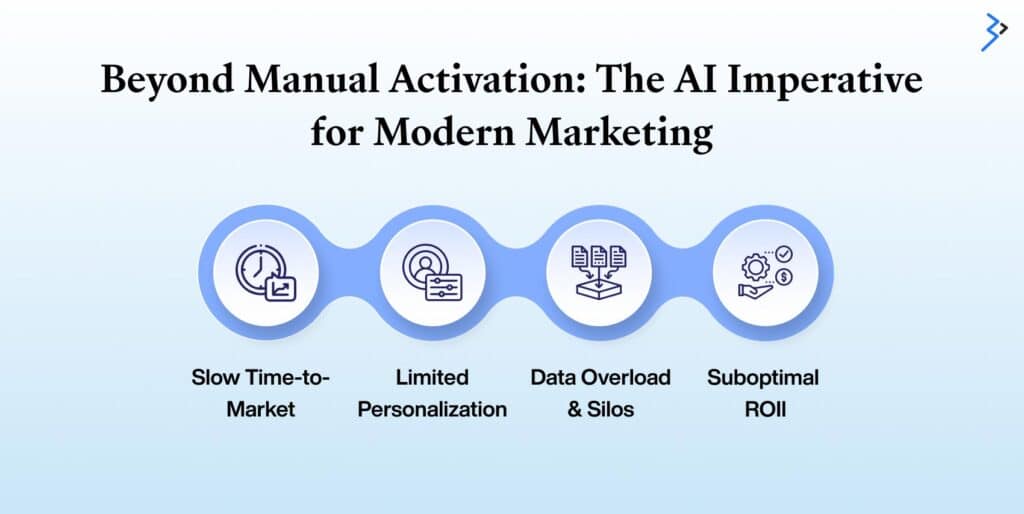
Audience activation has been a process fraught with manual hurdles for too long. Marketers spend countless hours sifting through disparate data, building segments, and orchestrating campaigns. This traditional approach often leads to:
- Slow Time-to-Market: Delays in campaign execution miss crucial opportunities.
- Limited Personalization: Manual efforts restrict tailored experiences for individual preferences and real-time behavior.
- Data Overload & Silos: Fragmented customer data makes unification and analysis challenging.
- Suboptimal ROI: Campaigns aren’t continually optimized to reach the most receptive audience.
Adobe Experience Platform‘s AI Assistant tackles those challenges. It is an intelligent co-pilot that enhances the Workflow by embedding generative AI and machine learning into the AEP workflows. Marketers, data analysts, and campaign managers can realize their strategies faster, with increased accuracy and complete customization. It moves AEP’s focus from just processing data to providing relevant outcomes quickly and intelligently.

The Core Pillars of Smarter Audience Activation with AEP’s AI Assistant
The AI Assistant’s power stems from democratizing complex data insights and streamlining operational tasks within AEP. It builds on unified customer data, applies intelligent insights, and automates activation at scale.
1. Unified Customer Profiles: The Foundation of Intelligence
At the heart of Adobe Experience Platform is the Real-Time Customer Profile (RTCP), which unifies all customer data—from online behaviors and transactions to offline interactions and preferences—into a comprehensive view. The AI Assistant employs a unified profile to deliver context-aware insights, ensuring that each audience segment receives the most complete and up-to-date understanding of customers.
- Operational Insights: The AI Assistant can query metadata about your AEP objects (datasets, schemas, audiences, destinations, journeys) to provide insights into usage, lineage, and data hygiene. For example, “Show me all segments that use ‘ProductInterest’ attribute” or “Which audiences are activated through Destination X?”
- Data Management & Governance: It helps users understand data flow, identify unused audiences for cleanup, and verify data lineage, promoting better data hygiene and governance within the platform.
Read More – Unlocking Operational Insights with an AI Assistant in Adobe Experience Platform
2. Intelligent Segmentation & Predictive Insights: Knowing Your Audience
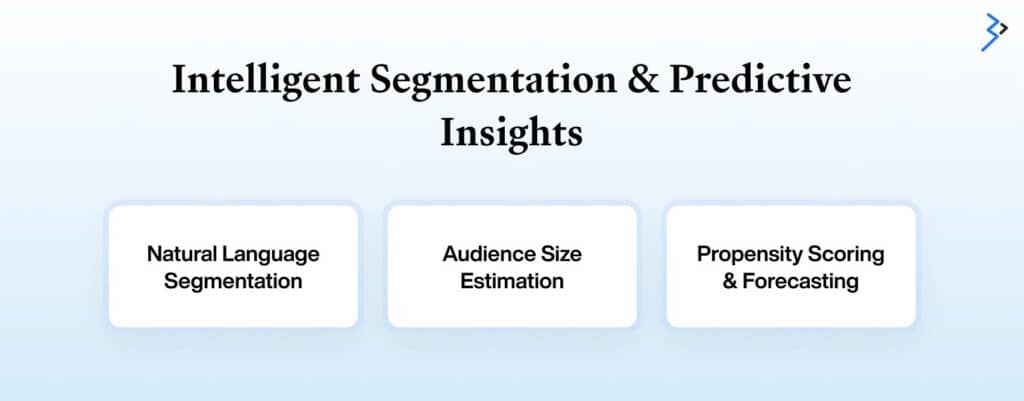
This is where “smarter audience activation” truly shines. The AI Assistant moves beyond basic segmentation to enable sophisticated, predictive audience creation.
- Natural Language Segmentation: Marketers use natural language prompts to create particular audience segments. Instead of complex segment builders, they can ask, “Create an audience of customers who viewed product category ‘X’ in the last 7 days but haven’t purchased, and have a high propensity to convert.” The AI Assistant then translates this into a functional segment.
- Audience Size Estimation: Get quick estimates of audience sizes based on natural language queries, reducing coordination time and allowing rapid idea iteration.
- Propensity Scoring & Forecasting: The AI Assistant leverages AEP’s Customer and Attribution AI to deliver predictive intelligence. It spots the customers most likely to churn (stop doing business), convert (begin doing business), and engage (interact with a brand or organization in meaningful ways), while even predicting audience size changes so that data-driven action can be taken ahead of time.
Leveraging AI for marketing can significantly improve efficiency and ROI. Companies implementing AI for personalization have reported increasing ROI by at least 400%. [Source: Instapage / Xerago]
3. Accelerated Activation & Journey Orchestration: Reaching Them Smarter
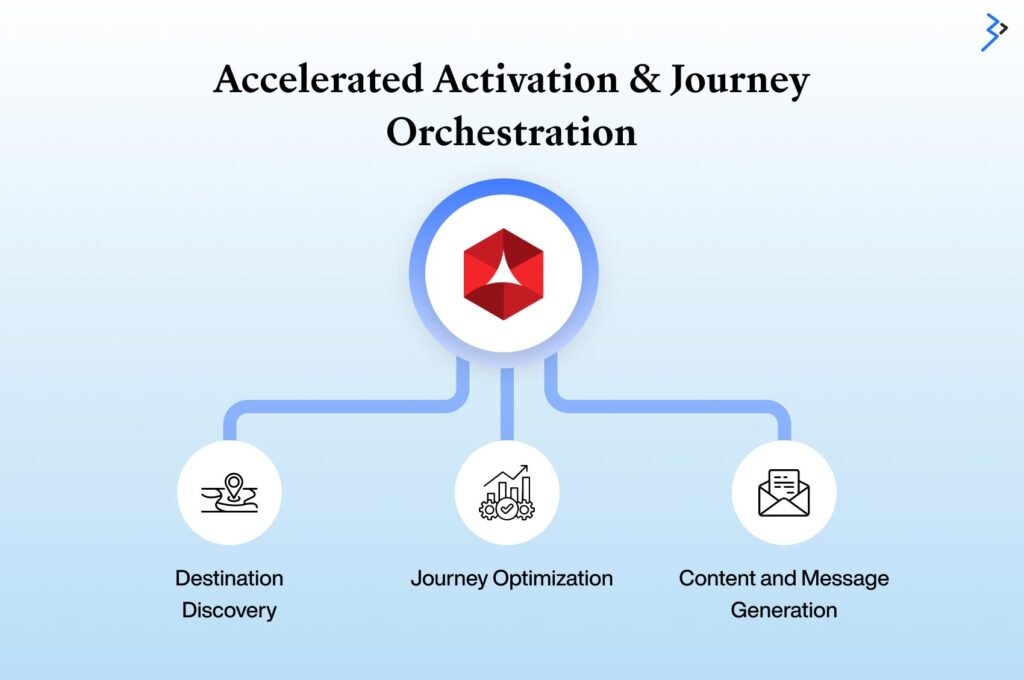
Once audiences are intelligently defined, the AI Assistant accelerates their activation across channels and orchestrates dynamic customer journeys.
- Destination Discovery: Identify relevant destinations (channels like email, mobile push, advertising platforms) where somebody can activate specific audiences.
- Journey Optimization: Gain insights into active journeys, identify audiences used within each, and help maintain journey hygiene. It can even assist in simulating journey outcomes to optimize performance before launch.
- Content and Message Generation (Future/Advanced): While initially focused on operational insights, future iterations hint at the AI Assistant, lePlatform’s generative AI development services like Adobe Firefly, helping generate on-brand marketing copy or even full message development for campaigns.
Technical Deep Dive: The Brains Behind the Assistant
The Adobe Experience Platform’s AI Assistant integrates advanced generative AI models, essential AEP services, and improved data processing capabilities, all designed for optimal performance and stringent data governance.
Generative Experience Models (GEMs)
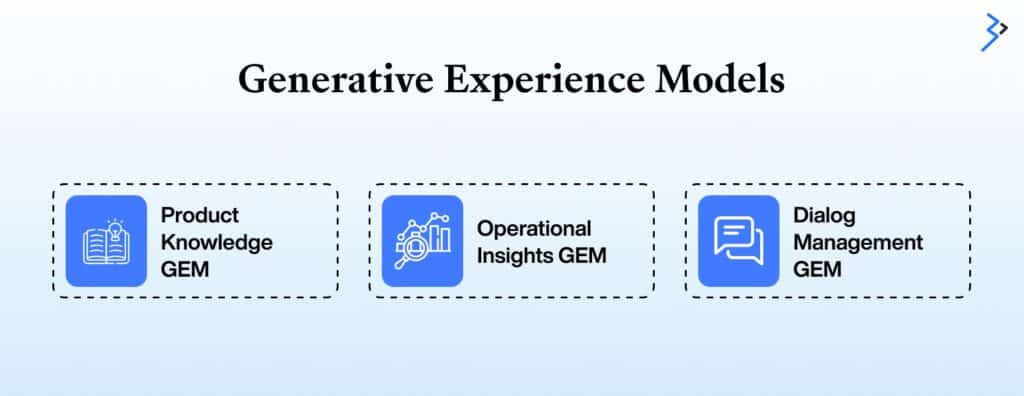
At its core, the AI Assistant is powered by Generative Experience Models (GEMs). These for Microsoft and custom models enable the conversational interface. Adobe leverages flexible, secure LLM services (like Microsoft’s Azure OpenAI Service) while ensuring customer data privacy and governance.
GEMs are categorized into:
- Product Knowledge GEM: Answers questions about Adobe product documentation, providing troubleshooting and learning guidance.
- Operational Insights GEM: Translates natural language queries into queries against customer-specific operational metadata, generating insights on usage, lineage, and hygiene.
- Dialog Management GEM: Orchestrates other models to provide engaging, multi-turn conversational responses.
Data Services & Knowledge Graph
The AI Assistant queries underlying data stores organized into a Knowledge Graph—a comprehensive web of concepts, data, and metadata. This includes general product knowledge and continuously updated customer-specific operational data in real time. AEP’s data organization allows GEMs to interact with complex data in a natural language fashion.
Integration with AEP’s Core Services
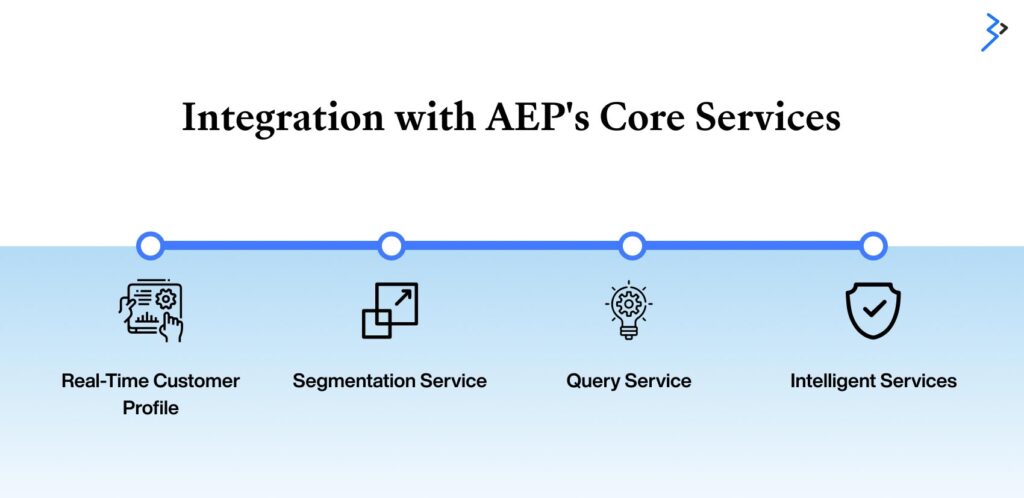
The AI Assistant works in tight conjunction with AEP’s foundational services:
- Real-Time Customer Profile: Provides the unified, up-to-date customer data.
- Segmentation Service: Enables creation and evaluation of audience segments.
- Query Service: Allows powerful ad-hoc querying of the data lake.
- Intelligent Services (Customer AI, Attribution AI): Delivers personalized and propensity scores that fuel more brilliant audience insights.
This architecture ensures the AI Assistant’s recommendations and actions are grounded in real-time, accurate, and overwoven customer data, making it a reliable tool for critical marketing decisions.
Fact: AI “assistants” in enterprise software are making powerful features more approachable and accessible to users. Users no longer need to have extensive SQL or navigational skills to use these features; they can ask them in natural language. It enables a broader group of marketers to use advanced features, decreasing reliance on a small group of experts.”
Read More – The Composable DXP Advantage: Building Agile Digital Experiences with Adobe Solutions
Analytics and Optimization: The Continuous Loop of Improvement
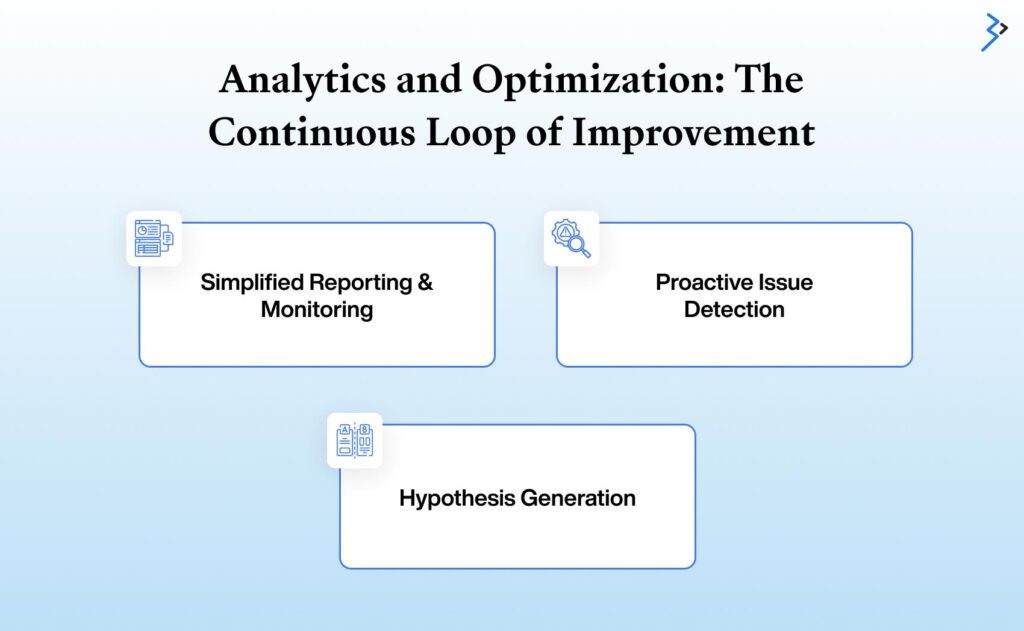
The advantages of the AI Assistant go far beyond its initial function. It promotes continuous learning and development by uncovering data insights and selectively highlighting the link between actions and their outcomes.
- Simplified Reporting & Monitoring: Ask the AI Assistant for key metrics about audience performance, journey progression, or campaign effectiveness in natural language.
- Proactive Issue Detection: The assistant can flag anomalies or significant changes in audience sizes, allowing marketers to investigate and prevent disruptions to activations quickly.
- Hypothesis Generation: By providing quick insights and simulations, the AI Assistant enables marketers to rapidly test hypotheses about audience behavior and campaign impact, accelerating the iterative optimization process.
Fact: Companies that tailor experiences for their customers observe an increase in spending, with customers typically spending 34% more when their experience is personalized. It highlights how effective audience engagement can boost revenue, especially by leveraging tools like the AI Assistant. [Source: Instapage / Salesforce]
Trust, Security, and Responsible AI
Trust and data governance are paramount when dealing with customer data, especially AI. Adobe has built the AI Assistant with strong ethical principles and robust security measures.
- Data Privacy: We handle customer data with the utmost confidentiality and security. Adobe prioritizes turning off logging for large language models (LLMs) when dealing with sensitive information and guarantees that customer data remains exclusive to each client.
- Transparency and Control: Users maintain control over their data. The AI Assistant explains that its operational insights and responses are verifiable and cited from trusted sources, including your enterprise data.
- Compliance: Built on AEP’s secure and compliant foundation, the AI Assistant inherits its robust data governance framework, helping ensure adherence to regulations like GDPR and CCPA.
Read More – From Chaos to Clarity: Optimizing Marketing Operations with Adobe Workfront and AI
Activating the Future with Brainvire and Adobe Experience Platform
The AI Assistant in Adobe Experience Platform is a significant advancement that gives marketing teams more power. It streamlines complicated processes, expands the depth of insight gained from customer data, and enhances the speed of activating audiences with hyper-targeting for better experiences and personalization at scale. It also turns data into action and puts advanced marketing capabilities into more people’s hands than ever.
While our dedicated page highlights our expertise with Adobe Experience Manager, our broader mission at Brainvire is to drive end-to-end digital transformation by helping businesses harness the full potential of Adobe’s complete ecosystem.
Our deep expertise extends across the entire Adobe Commerce Cloud Services, including platforms designed for real-time customer data management, intelligent services, and audience activation like Adobe Experience Platform.
At Brainvire, we understand the intricate technical nuances and strategic foresight required to harness such powerful technologies. Our experts collaborate with businesses to integrate, streamline, and enhance the value of their heat technology and develop innovative digital capabilities to achieve measurable business results. If you are looking to unify your customer data, engage more intuitive audiences, or personalize experiences, Brainvire is the partner for you.
Are you ready to utilize the power of AI-based audience activation and take your customer experiences to the next level? Contact Brainvire to learn how we can help enhance your digital strategy with Adobe technology.
FAQs
The AI Assistant in Adobe Experience Platform (AEP) uses AI to help marketers with smarter audience activation. It simplifies data analysis, segmentation, and journey orchestration for personalized customer experiences.
It boosts personalization by enabling natural language segmentation and using predictive AI. This identifies key customer groups and provides insights for highly targeted and relevant customer interactions.
Yes, AEP’s AI Assistant integrates with vital systems like CRMs, ERPs, and marketing automation platforms. This ensures consistent data flow and automates workflows across your digital ecosystem.
Yes, it’s designed with enterprise-grade security and privacy. AEP’s robust framework ensures data encryption, access controls, and compliance with regulations like GDPR and CCPA, protecting sensitive customer data.
Marketers gain faster campaign launches, increased productivity, deeper audience insights, and improved ROI. It streamlines complex tasks, enabling more dynamic and effective customer engagement.
Related Articles
-
Turning Listings into Living Stories: Adobe’s Impact on Real Estate
The real estate world is changing dramatically. What was once all about paperwork and shaking hands is now a digital success story. A brand’s website is its most crucial shop
-
Adobe Commerce Security Best Practices: Safeguarding Your Online Store
In the fast-paced digital era, where online shopping has become a norm, the security of e-commerce platforms is of paramount importance. According to recent studies, a staggering 88% of skilled
-
Unlocking Operational Insights with an AI Assistant in Adobe Experience Platform
Designed as a generative AI tool, the AI Assistant in Adobe Experience Platform will transform how consumers interact with Adobe Experience Cloud apps like Adobe Customer Journey Analytics, Adobe Real-Time




